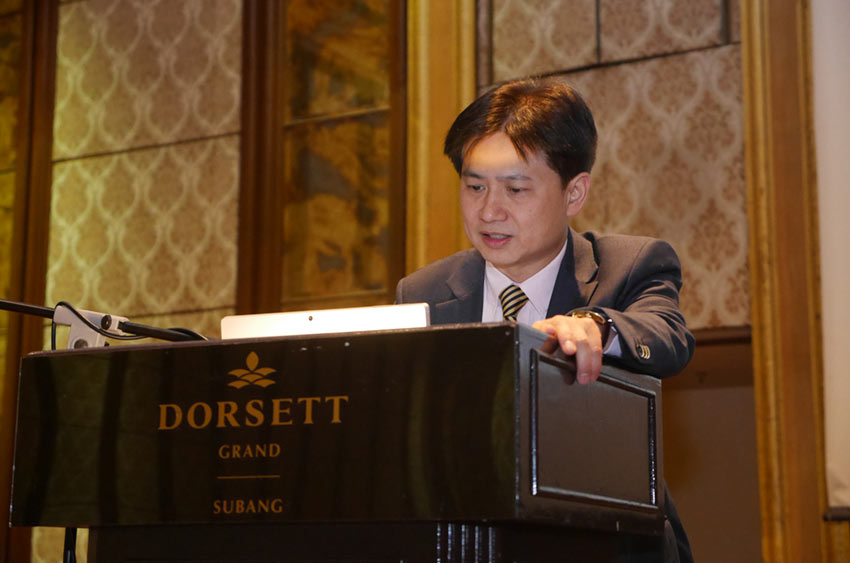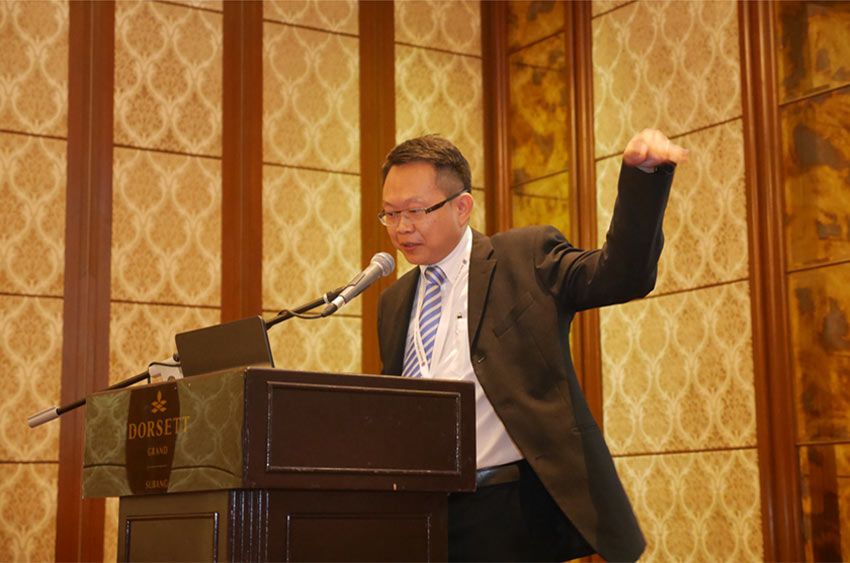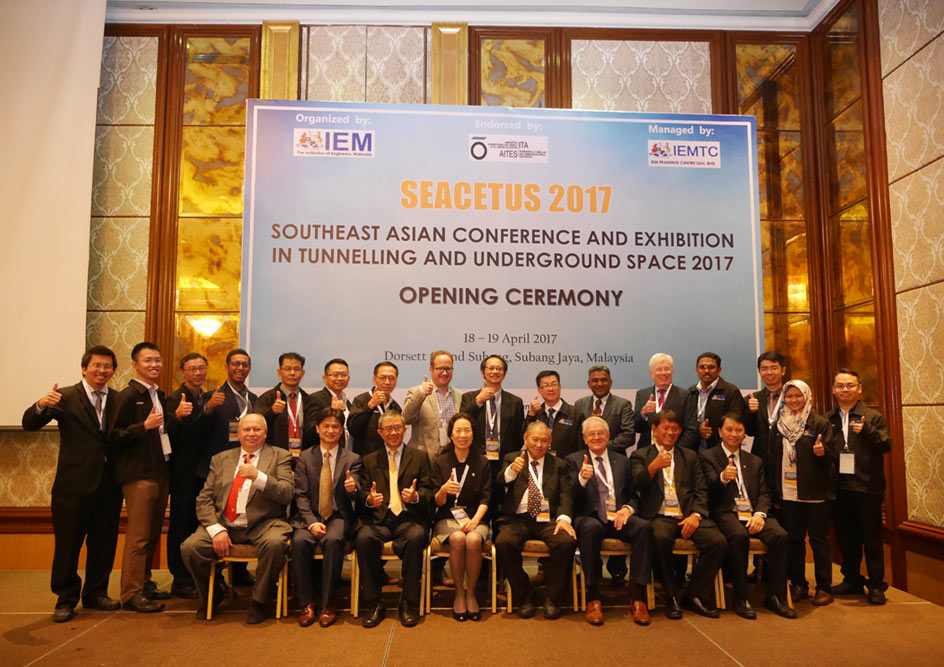Malaysia hosts excellent SEACETUS 2017 08 Jun 2017
"After the success of SEACETUS 2017 Kuala Lumpur is keen to host the 46th ITA General Assembly and WTC in March 2020," explained Dr Teik Aun Ooi, organizing chairman of the future plans of Malaysian Tunnellers in a brief statement for TunnelTalk.
Dr Ooi together with Tan Yean Chin, President of the Institution of Engineers, Malaysia (IEM), welcomed almost 400 participants and over 20 exhibitors to the first Southeast Asian Conference and Exhibition in Tunnelling and Underground Space (SEACETUS) in the Subang Jaya district of Kuala Lumpur, Malaysia from the 18th to 19th April 2017. Good organisation, choice and quality of the presentations at the recent conference, together with past and future development of underground space in the region with innovative, challenging and outstanding projects are reasons why Kuala Lumpur wants to host the WTC 2020. It is one of the most attractive cities in Southeast Asia according to a Bangkok Post report, with 11.3 million overnight visitors in 2016.
SEACETUS News
The two day conference, with the theme of Innovation and Sustainable Underground Space Development, aimed to "promote the sharing of knowledge, experience, skills, ideas and achievements in the designing, financing, contracting, construction, operation and maintenance of tunnels and other underground facilities among the ASEAN countries on an organised basis with agreed aims," said Dr Ooi.
The programme, which included nearly 60 presentations, started with an opening address by Professor Jenny Yan, ITA Vice President and Deputy General Manager, China Railway Academy Co. There were four keynote lectures, nine special lectures and 32 papers. During breaks delegates were able to look around the exhibition and chat with colleagues or make new contacts.
Professor Yan gave an overview of tunnelling progress in China. More than 20,000km of tunnels are currently under construction with many others in the planning and design process. In the past 15 years around 40,000km of tunnels have been built for railway, highway, metro and water. She spoke of the 34km Gaoligong mountain railway tunnel, the 18km Qinling Zhongnan mountain highway tunnel and the 98km Qinling water tunnel. Examples of Chinese tunnels with extra deep overburden, large cross sections, high ground stress or complex geology seemed to be countless.
Chinese tunnellers will also be undertaking long subsea projects in the next few years, such as the 30km long Qiongzhou Strait tunnel with the challenges of deep long distance tunnelling under ultra-high water pressure. The Bohai Bay tunnel and Taiwan Strait tunnel, both over 120km in length, will also offer challenges as tunnellers face poor geological conditions, high seismic intensity, long distance construction and disaster prevention in operation.
Keynote lectures
Four keynote lectures gave more insights into special projects and topics in Southeast Asia.
Professor Kwet Yew Yong, Vice President of the National University of Singapore, described challenges in the construction of the Singapore Thomson-East Coast Line (TEL). This is the sixth MRT line in Singapore and will be 43km long with 31 stations including 7 interchanges. Construction started in 2014 (stage 1 to 3) and in 2016 (stage 4 and 5, East Coast). Operation is planned to start in phases from 2019 to 2024. He described the challenges facing engineers as the tunnel will pass through highly variable ground conditions and densely developed areas. The Singapore government plans to invest around US$70 billion over the next 10 years to increase the network and transport system. Constructing new MRT lines will become increasingly challenging as new lines will pass under existing infrastructure and operating rail tunnels. In addition, the 35km long and 6m diameter wide Transmission Cable Tunnel Project for Singapore Power has just been completed at a depth of 50m and using 18 TBMs. Phase 2 of the Deep Tunnel Sewerage System (DTSS) will start shortly.
The "three-dimensional interaction of multiple perpendicularly crossing tunnels with circular and horseshoe-shaped cross-sections" was described by Professor Charles Ng, Hong Kong University of Science and Technology (HKUST), along with a number of recent advances in tunnel-related research. Three-dimensional centrifuge model tests and numerical backanalyses were conducted to investigate the interaction of multiple crossing tunnels. Factors influencing the interaction, i.e. construction sequence, cover depth of tunnels, pillar depth of tunnels, shielding effects and tunnel shape, were investigated and the results explained.
Poh Seng Tiok, MRT Corporation, Malaysia, gave an overview of the BIM implementation for the Sungai Buloh-Serdang-Putrajaya(SSP) line with his presentation "Advances in engineering technology and its applications in the Klang Valley MRT (SSP Line 2)." It is a rail-based public transport network which together with the existing urban rail network will form the backbone of the public transport system in the Greater Kuala Lumpur/Klang Valley region. The first MRT line to start construction was the 51km Sungai Buloh-Kajang (SBK) line which began in July 2011 and is scheduled to be operational in 2 phases, December 2016 and July 2017. The SSP Line is the second MRT line to be developed and will serve a corridor with a population of around 2 million people stretching from Sungai Buloh to Putrajaya. The SSP alignment is 52.2km long of which 13.5km is underground. A total of 37 stations with 11 underground will be built.
Dr Lean Hock Ooi, MMC Gamuda KVMRT, Malaysia, gave his presentation "Positioning to undertake underground works contracts – a Malaysian experience" about how difficult it is to develop a well performing tunnelling industry in a country where no local companies existed before. The demand for more sustainable urban transportation infrastructures in Malaysia and especially in the Kuala Lumpur area made it necessary to develop an effective urban transportation system using a regional player. As a contractor with the vision to help the nation to achieve such objectives and to be developed nation, MMC Gamuda started to develop the construction building company into a specialist for tunnelling and underground stations in Malaysia and the Southeast Asian region.
"I would like to show how we have to position ourselves as a local contractor to undertake such projects with the primary objectives of developing and utilising local expertise and resources," Dr Ooi explained. He presented a range of examples in the different fields of underground and tunnel solutions, and explained how the company invested in training the younger generation under the mentorship of experienced expatriates. TBM refurbishment is another key area for Malaysia.
Special lectures
The nine special lectures included an address from Dr Harald Wagner from Bangkok, who spoke on risk management concepts in underground works and noted that "in general, tunnelling is cheaper than building elevated structures". Gus Klados from Malaysia made significant contributions with his address on the birth of a new technology - the variable density tunnel boring machine and Zaw Zaw Aye from Bangkok, Thailand explained the geotechnical aspects of a cut-and-cover tunnel construction under an existing flyover in Bangkok. Dr Benson Hsiung from Taiwan outlined two case studies of deep excavations in Kaohsiung (Taiwan) and Central Jakarta (Indonesia). Professor Noppadol Phien-wej from Thailand gave insights into the difficulties due to rise in groundwater pressure in recent MRT underground construction in Bangkok. John Davis from Singapore revisited the design and construction of Wanchai MTR Station in Hong Kong which was built in the early 1980s under a different ground model. Alexander Mackay from Kuala Lumpur gave an overview of the project, the ground and the groundwater conditions relevant for the grout injection beneath the Hong Kong Express rail link, West Kowloon Terminus perimeter wall where more than 6 million m3 of material were removed. The last but not least presenter of these very interesting special lectures was on the second conference day - Andreas Raedle from Singapore gave an overview of the Crossrail C310 Thames Tunnel-mixshield TBM tunnelling in alternating ground conditions with low overburden.
At the end of two very exhausting, but very interesting conference days with much information, all particpants said they hoped to meet again for the World Tunnel Congress 2020 in Kuala Lumpur.
References
- Norway prepares a royal WTC welcome – TunnelTalk, May 2017
- KVMRT to repeat Line 1 success for Line 2 – TunnelTalk, April 2016
|
|
|
|
|
Add your comment
- Thank you for taking the time to share your thoughts and comments. You share in the wider tunnelling community, so please keep your comments smart and civil. Don't attack other readers personally, and keep your language professional.



















